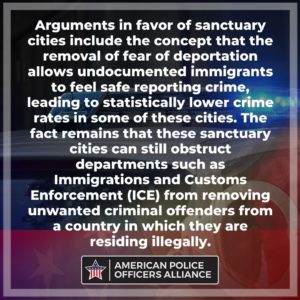The sanctuary city concept has evolved since its first appearance in the 1980s. Historically speaking, the idea of a sanctuary city stems from the plight of immigrants fleeing religious and other violent persecution. In turn, many cities opened their doors to those fleeing dangerous conditions. In the 1980s, many American cities began operating with sanctuary legislation as a challenge to the government’s stance on refugees coming from Central America. The idea of a faith-based sanctuary city started in the country’s Southwest region and has since taken root in over 500 jurisdictions around the United States. In the face of the current immigration crisis and the divisiveness of the politics surrounding it, it’s time to look at the functionality and ongoing purpose of these sanctuary cities.
Tension Between Federal, State, and City Governments
The tension between sanctuary cities in the U.S. and the federal government has escalated in recent years. Arguments in favor of sanctuary cities include the concept that the removal of fear of deportation allows undocumented immigrants to feel safe reporting crime, leading to statistically lower crime rates in some of these cities. However, while the benefits for those who are on the path to obtaining legal citizenship are numerous, the fact remains that these sanctuary cities can still obstruct departments such as Immigrations and Customs Enforcement (ICE) from removing unwanted criminal offenders from a country in which they are residing illegally.
Pros and Cons of Sanctuary Cities
Here’s a closer look at sanctuary cities pros and cons.
US Justice Department Sues California
In 2018, the U.S. Justice Department sued the state of California for its refusal to comply with detainer requests and other protocols put forth by ICE. For its part, California has held to its sanctuary statutes fiercely, promising illegal immigrants asylum and encouraging them to integrate into their communities to feel safe and at home. However, the Justice Department and the Trump administration took issue with this, stating that these sanctuary laws put an undeniable strain on federal law enforcement and ICE by not cooperating. In the efforts of ICE to remove violent criminals and multiple offenders from the country, many sanctuary cities are making this next to impossible. As a result, the free reign of violent criminals who have been released back into the public after local law enforcement refused to complete an ICE detainer request for further investigation has resulted in crimes that could potentially have been prevented.
Repeat Offenders Not Being Deported
Take the example of Juan Francisco Lopez-Sanchez, an undocumented immigrant who accumulated seven felony convictions and was deported five times, re-entering the U.S. after each deportation. After another release from detention in San Francisco, Lopez-Sanchez was charged with the shooting death of a local woman. The details surrounding the case are fraught with angst and tension, but the fact remains that the five-time deportee returned to the country and took the life of a citizen. This is just a single example of the failure and breakdown of relationships between local and state law enforcement and the federal organizations tasked with protecting borders. In fact, during eight months in 2014, over 60 percent of the undocumented immigrants released from detention had previous criminal convictions.
Rejecting ICE Detainer Requests
The root of the issue at hand here is an absence of cooperation between the levels of law enforcement. Digging further, the idea of loyalty to the concept of open arms and welcoming those fleeing persecution permeates those who have dug in on the side of the fence that wants to block ICE from making raids and arrests in sanctuary cities. At the very least, many sanctuary cities have put protocols in place that prevent employees from having to inquire about a detainee’s citizenship status. In other cases, local and state law enforcement can refuse a detainer request submitted by ICE for a detainee who has piqued interest for further investigation.

To thwart these sanctuary cities from refusing to comply with detainer requests and other protocol, President Trump in 2018 issued an executive order stating that a jurisdiction’s refusal to comply would make them ineligible for federal grants and other financial support. While federal courts would eventually strike this order down as unconstitutional, the bottom line remains that the Trump administration is set on enforcing stricter protocol when it comes to removing violent and repeat criminal offenders from their illegal residence in the United States.
At the end of the day, the federal law enforcement agencies such as ICE still have the authority to detain and deport undocumented immigrants. In addition, voluntary programs such as 287(g) allow local and state law enforcement to undergo proper training so that they may also enforce immigration law. It is beneficial for states and local law enforcement to work with ICE positively to keep the U.S. and its citizens safe.
Wastes Resources & Discourages Legal Immigration
Instead of creating more legal red tape and loopholes that allow criminal offenders to roam freely, law enforcement agencies need to work together to bring criminals to justice while allowing those who are not offenders to obtain citizenship on the legal path. The resources that are wasted in the refusal to communicate and comply are preventing the country from moving forward to a modern immigration model that both encourages people to want to come to the country legally and also discourages criminals from crossing the border illegally and committing crimes in the U.S.
The path forward is, unfortunately, murky. The U.S. Constitution does not clearly outline protocol for immigration law, which makes the battle between state and federal governments that much more unclear and divisive. With the focus on power moves and financial backing, immigrants will find they’re no more than political pawns. Only by focusing on the foundational values of the U.S. — the idea that safe harbor can and should be found for those with sufficient reason to flee their current homes — can local and federal law enforcement find a way to work together for the country’s greater good.
Crimes Could be Avoided
Crimes could be avoided if immigration control could do its job properly. Sanctuary cities’ refusal to comply on a massive scale inhibits this process. For instance, an undocumented immigrant cannot be arrested in many sanctuary cities until or unless they commit a crime on U.S. soil. With this idea in mind, remember that many violent criminals cross into the U.S. illegally. For this, local law enforcement cannot arrest them in a sanctuary city. Instead, it’s a waiting game to find out if the undocumented immigrant commits a crime, violent or otherwise. Only then can the offender be detained — but whether or not ICE is contacted for further investigation is a point of contention and where the process becomes even more bogged down. In many cases, the offenders are simply released without ICE being notified.
Examples such as this are not a rarity and are symptomatic of the greater issues facing immigration law in this country. Proper and fair legislation must be implemented to allow immigration officers to do their jobs. The priority should always be public safety and encouraging immigrants to obtain citizenship legally. To achieve both objectives, we must have a law enforcement environment that promotes cooperation and fair practice.
American Police Officers Alliance stands by the idea that criminal illegal immigrants cannot be allowed to have sanctuary in certain cities because it adds untenable strain to local police officers, infrastructure, and resources. American Police Officers Alliance supports initiatives to keep our cities free from sanctuary for the safety of American citizens.
For a complete list of sanctuary cities in the US, visit this page.
For a complete list of non-sanctuary states in the US, visit this page.
Border security remains a hot topic of discussion, and no matter what side of the political spectrum individuals may fall on the fact remains that protecting both borders from illicit or illegal activity and crossings is of utmost importance for the safety of all involved. Read more here.









